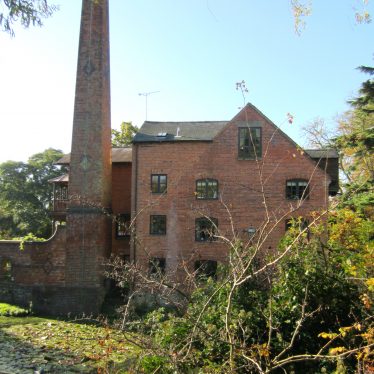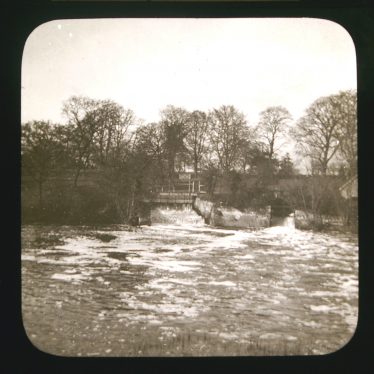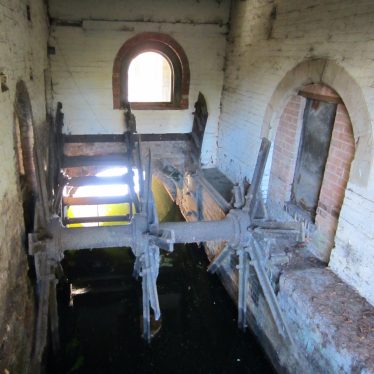I could find no sign of a mill at Blackdown in the Domesday book, though it may be quite ancient. Bertie Greatheed writes in his diary for August 12th 1807: “In the evening I rowed her [Mrs Damer] and Mary [Berry!] nearly to Blackdown Mill. A sweet evening. Mary picked up an egg floating upon the waters…but it proved addled.” 19th-century trade directories record a corn mill here and in 1900 Whitehouse & Co.’s steam and water mill. Water millers are mentioned up until 1916, but not thereafter. A mill with weir and mill pool are shown on the OS map of 1900.
The mill buildings today
Looking at the modern map I thought the mill had disappeared, to be replaced by some engineering works. However when I went to take my ‘after’ picture (expecting barbed wire and no access) I found the 18th-century mill buildings still very much present, complete with mill pool, chimney, overhead hoist and a window giving an intriguing view of the remnants of the mill wheel (shown in the photo). It’s no longer a working mill, but the character has been sensitively retained and it makes a splendid contribution to the landscape. Strangely the weir – seen clearly in the earlier picture – seems to have disappeared, with the river flowing placidly by the mill.
Gracious living
I got quite excited when I googled ‘Blackdown Mill’ and found that Daniel Craig and his wife were said to be interested in buying the mill for around £5 million (it does have 8 bedrooms and a private cinema). Sadly this rumour proved to be untrue though you could have rented the place for £3.5K a month back in 2010.
A trip down the River Avon revisited
This is part of a series of ‘before and after’ photographs based on the Rev. E.N. Dew’s lantern slides for a talk about the Warwickshire Avon. The original photos date from around 1900 and the linked article explains the history of the photographs.
Bertie Greatheed owned Guy’s Cliffe; his diary for 1806-7 can be examined at the Warwickshire County Record Office (reference CR 1707/117) and a transcription of it will shortly become available, recommended because Bertie’s handwriting is hard work!










Comments
Back in the late 1960s I used to work at the mill for a Mr Charles Fellows and his family when it was an Antiques shop. They used to restore the furniture, employing two carpenters and a french polisher, and I was the trainee. I used to do a bit of everything including dusting, vacuuming and mowing the lawns.
Many thanks Alan for interesting memories. Were they using the mill wheel to drive wood-working machinery?
Blackdown is historically part of Lillington township – and used to be in Lillington parish until the 1950s. One of Lillington’s two Domesday entries includes a mill, held by the Count of Meulan, worth 6s 8d – which is believed to be Blackdown Mill.
I also noticed that your photograph of the weir and sluice is printed laterally inverted – the sluice should be on the right of the weir, and the gable of the boathouse should be visible to the right of the sluice. See the OS 1:2500 2nd edition (1900-1906).
Many thanks for the information and correction Diana, the photo’s been changed. It still doesn’t explain how the weir has disappeared!
Add a comment about this page